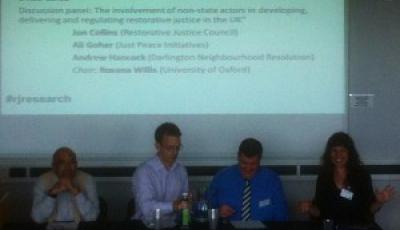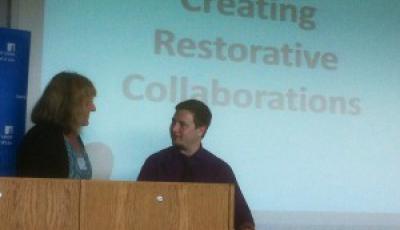The Inaugural Conference of the Community of Restorative Researchers
Posted:
Time to read:
Post by Naomi-Ellen Speechley, researcher at the Centre for Criminology
The Community of Restorative Researchers is an interdisciplinary network, uniting academics and practitioners working in restorative justice (RJ) to promote an open and critical dialogue. On 7 July 2015, I attended the network’s first conference, hosted by doctoral researcher and network coordinator Ian Marder (University of Leeds), which aimed to consider the role of state versus non-state actors when developing, delivering, and regulating restorative justice.
Ian’s welcoming address called for a need for collaboration and cohesion between RJ practitioners, particularly given the growing number of localized and widely varied RJ programmes. Against the context of scant state monitoring, Ian located this trend as being somewhere between a ‘thing of beauty’ and a ‘disorganized mess.’ The conference adopted an innovative approach by using panel discussions as a platform for contributors to exchange views from their own areas, rather than calling for papers, thereby enabling conflicting viewpoints to be explored and challenged through conversation.

The conference’s second panel centred on the involvement of state actors in developing, delivering, and regulating RJ in the UK. It was comprised of Jonathan Doak (Durham University), Nicola Preston (International Institute of Restorative Practices), and Becky Beard (Restorative Gloucestershire), and was chaired by Elizabeth Tiarks (Durham University). Debating whether a centralized RJ provider would work, Becky argued that the varied and localized needs of individual areas were too different to be adequately met by a sole body or a set service. She further warned that restorative measures don’t always work as they are expected to, because offenders are often victims too (or feel like them). Therefore, progress lies in working with offenders’ motivations to stop reoffending, such as their responsibilities towards family members. Jonathan added that RJ works best at a localized level; consequently, there are inherent risks in trying to set up an umbrella service. However, he argued that there’s a need for services to be ‘joined up’ and consistent. Nicola drew from her teaching experience, advising that it’s crucial to monitor the content of any restorative provision closely, but that organisations like the Restorative Justice Council should oversee performance. Becky argued that RJ should be co-facilitated by community volunteers and paid staff who had no stake in the conflict. Although police officers could be suitable facilitators, this could cause tension for community-police relations. Nicola suggested that given the importance of neutrality, it was irrelevant whether facilitators were state or non-state actors because, essentially, it’s the person’s skills and knowledge that count most.
The conference keynote, ‘Creating Restorative Collaborations,’ was delivered by Deborah Mitchell (RJ Working Community Interest Company and University of Exeter). She began by defining RJ as encompassing ‘safe, supported, voluntary communication between the person harmed and the person who caused harm, for the purpose of pair and recovery,’ qualifying this by warning that each word is deceptively simple. Deborah showed a video depicting a prisoner mocking the suggestion of meeting and talking to his victim, only agreeing after considering that it might improve his record. The clip demonstrated the complexities involved in arranging restorative measures because the motives aren’t always readily apparent and the benefits can become obscured. Deborah identified the main barriers to collaboration between practitioners: competition for cases, funding, a win/lose philosophy, territorial behavior, overzealous control, and refusal to share strategies and resources. To counter this, she suggested ‘alliance contracting’―a technique borrowed from the construction industry, whereby individual providers co-contract their services to secure cooperation and collaboration in order to see a project completed.
The speakers prompted some valuable discussion, collectively identifying potential opportunities for RJ practitioners to collaborate with schools, social workers, and student placements as well as police, which creates a ripple effect into education and family care, fostering potential crime prevention effects. In his closing remarks, Ian reflected on the need to increase restorative training and awareness, and the promising potential for former offenders to become facilitators, or for university students to be considered as a resource, often having more time and focus than professionals.

Keywords:
Share:
